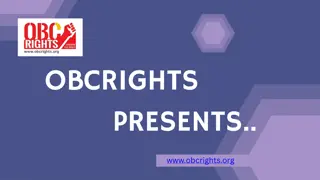Understanding Hyponatremia: Clinical Presentation and Management
Nurse-Doctor Co-Teaching presents a case study of a 63-year-old woman with hyponatremia, discussing key observations and factors relevant to her condition. The session aims to simplify the complexities of hyponatremia by reviewing the importance of correction rates, providing a framework for patient evaluation, and highlighting symptoms related to anti-diuretic hormone. It emphasizes quantifying oral intake and identifying sources of water intake while addressing potential complications like cerebral edema. The safe correction rate for hyponatremia and recommended diagnostic studies are also outlined for better understanding and management.
Download Presentation

Please find below an Image/Link to download the presentation.
The content on the website is provided AS IS for your information and personal use only. It may not be sold, licensed, or shared on other websites without obtaining consent from the author. Download presentation by click this link. If you encounter any issues during the download, it is possible that the publisher has removed the file from their server.
E N D
Presentation Transcript
Nurse-Doctor Co-Teaching Presents: The Ins and Outs of HYPONATREMIA Stephanie Simons, B.S., RN and Glen Kim, M.D., MPH
A 63 year-old woman is admitted overnight with abdominal pain, fatigue, and a sodium level of 121. You walk into her room in the morning and this is what you see. What are 5 things that you notice (that are relevant to her low sodium)?
Interpreting this clinical vignette and photo in the context of her low sodium, what are 5 things that you notice? Pain or stress, which could worsen hyponatremia Plate covered, i.e. not eating, could contribute as well Free water on the tray IV connected, which could be a lot of things, beneficial or harmful Banana, providing K, which is therapeutic for hyponatremia Bedside commode , which might imply diarrheal volume losses in the setting of abdominal pain
Hyponatremia is complex!!!! Lets try to simplify it Learning objectives for this co-teaching session include: 1. Review why we care about the rate of correction of hyponatremia 2. Learn a framework for thinking about patients with hyponatremia 3. Recognize symptoms that stimulate anti-diuretic hormone (ADH) 4. Quantify oral intake in the hyponatremic patient 5. List overlooked sources of water intake
Cerebral Edema If you do not correct Hyponatremia
What is a safe rate of sodium correction? Feared complication = Osmotic Demyelination Syndrome (formerly called Central Pontine Myelinolysis) Mild hyponatremia = 130-134 mEQ Moderate hyponatremia = 120- 129mEQ Severe hyponatremia = <120mEQ Maximum = 8 mEQ in a 24- hour period for severe, chronic hyponatremia N Engl J Med 2016; 374:e8 DOI:10.1056/NEJMicm1504134
What studies should we order to determine etiology? Serum: Basic metabolic panel Serum Osmolality TSH Am cortisol Depending on the Na level, recheck BMP every 4-12 hours Urine: Urine Na Urine Osmolality Best if urine sample obtained at the same time as basic metabolic panel!!
How much Water can one drink? Young and Healthy Elderly ETOH Lung Tumor PO Solute 600-900 300 400 600 Urine Osm 50 150 100 600 (Animate) 18 L 2L 4L 1L Dx Psychogenic Tea and Toast Beer Potomania SIADH
Putting it All Together! Three Physiology Factoids Three Key Questions Diagnosis 1) ADH @ distal nephron retains water 1) Something bad is likely stimulating ADH. What is it? Could be anything! And not just ADH-secreting tumors. Any physiologic stressor can stimulate ADH 2) You can t urinate only free water. Nephrons need solute to dump water (e.g. Salt tabs are given not to raise the Na, but to help dump water) 2) Is the patient eating? Think about reasons for low PO intake: Is it elderly, starvation, substance abuse, depression, food insecurity? 3) Urine Osm relates #1 and #2 and tells us the water limit 3) is patient getting extra fluids at bedside? IV drips, IV meds, pink pitcher
How do we measure strict Intake and Output? What are the steps we need to take? Put sign on the door Talk to patient care assistant (PCA) Talk to patient! How do we teach the patient? Ice chips count as fluid! How do we track the intake? Various methods depending on the patient Remember that IV medications also count towards the total intake
























